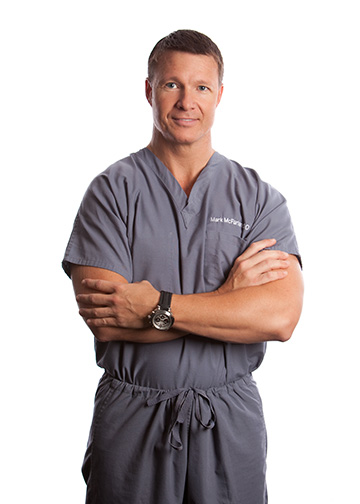 Mark McFarland grew up listening to stories about his great-grandfather, Dr. Bruce Inman, a well-respected surgeon who traveled around rural Oklahoma in the 1920s and 30s, doing basic surgery and taking care of patients who paid him with whatever they had on hand. Dr. McFarland’s grandmother, a nurse, became another factor in his decision to pursue medicine as a career. He knew early on that he wanted to follow in their footsteps. His parents, both educators, supported his decision enthusiastically.
Mark McFarland grew up listening to stories about his great-grandfather, Dr. Bruce Inman, a well-respected surgeon who traveled around rural Oklahoma in the 1920s and 30s, doing basic surgery and taking care of patients who paid him with whatever they had on hand. Dr. McFarland’s grandmother, a nurse, became another factor in his decision to pursue medicine as a career. He knew early on that he wanted to follow in their footsteps. His parents, both educators, supported his decision enthusiastically.
He received his undergraduate degree in physiology from Oklahoma State University in Stillwater and, initially opting for a career as a Physician’s Assistant, enrolled in the PA school at the University of Oklahoma-College of Medicine in Oklahoma City. He took a position with an orthopaedic surgeon at the same time. He’d been an athlete in school (basketball, baseball and football) and had developed an interest in orthopaedics when he met the surgeons who cared for him and his teammates on the field. And, he remembers, “During my PA training, I found that I really enjoyed orthopaedics. I really liked sports and sports medicine.”
He worked as a PA for the orthopaedist for a while, he says, “when something clicked, and I knew I wanted to be doing the surgeries, not assisting with them.” He was just 22 when he applied to and was accepted at the University of Oklahoma-College of Medicine in Tulsa. He received his Doctor of Osteopathy degree in May of 1999.
“I knew I wanted to do surgery,” Dr. McFarland remembers. He completed a traditional internship in orthopaedics and a residency in orthopaedic surgery at Ohio University Doctors Hospital in Massillon, Ohio. He enjoyed, and still enjoys, everything about surgery. “I enjoy treating conservatively to see how much we can accomplish that way. It also gives me great satisfaction to go into the OR and make a difference right then and there in the lives of my patients,” he says. He wanted to be able to perform joint replacements and arthroscopic procedures when his patients needed them.
During his residency at Doctors Hospital, he met Dr. Jeff Cochran, who he calls “an amazing surgeon.” He says he was lucky because there were so many talented surgeons at Doctors – and luckier still because many of his fellow residents weren’t interested in spine surgery. “I was able to take extra rotations with Dr. Cochran,” Dr. McFarland says, “and after I worked with him just a few months, I had made up my mind.”
He did a fellowship in spine surgery at the Florida Spine Institute in Tampa/Clearwater, and found that he really liked doing the complex, protracted spine procedures that many surgeons avoid. He admits it’s not the easiest path: “Spine surgery is one of the toughest procedures we do as orthopaedic surgeons, with the most riding on the outcome for the patient.”
Today, as a member of Orthopaedic & Spine Center, Dr. McFarland’s practice consists of 75 percent spine patients, and the rest joint replacements and sports medicine procedures.
And yet, this surgeon says that surgery is always his last thought. “I’m very conservative,” he explains. “I don’t take patients to surgery unless I’m sure they can have a good outcome.”
“It’s true,” he continues. “If we don’t have to be invasive to treat a patient, we won’t. I know that patients only see a doctor because they have some ailment, or because they’re in pain. No one comes to see me because they want to have surgery – they just want to get better.”
But he also knows that problems arise when people wait too long to see an orthopaedist. “We understand their fear of surgery,” Dr. McFarland says; “but unfortunately, too often patients who put off making an appointment to avoid surgery can develop other problems in the meantime, and deprive themselves of the conservative modalities that we can offer – and they wind up needing more complicated surgery. There are so many things we can do for patients today, so many ways to make people better without taking them to the operating room.” So many, in fact, that fully 95 percent of his patients are never scheduled for surgery.
As more and more non-surgical techniques and other modalities become available, that figure may go up. “Every day, we’re coming up with innovative new ways to treat people that don’t involve surgery,” he says. “There’s exciting new stem cell research that will help people with arthritic knees, arthritic hips, and even degenerative discs in their spines.”
He explains: “It’s a degenerative cascade when these discs start to wear out. Right now, we really don’t have a treatment other than managing them with therapeutic medicines, injections, and ultimately surgery. But in the future, we’ll be able to put medicine, or stem cells, directly into those discs and get them to regenerate. There are many researchers working on this now. It’s been done with animal models that show its effectiveness.”
In addition, joint replacements are becoming even more minimally invasive with computer-assisted surgeries. “The placement in the body is just about perfect,” he says, “and gives the patient excellent range of motion with an implant that won’t wear out as quickly.”
Spine surgery and joint replacements are “a bit of a different mix for an orthopaedist,” Dr. McFarland concedes, “but that’s how my practice has developed, and I absolutely love it.”

